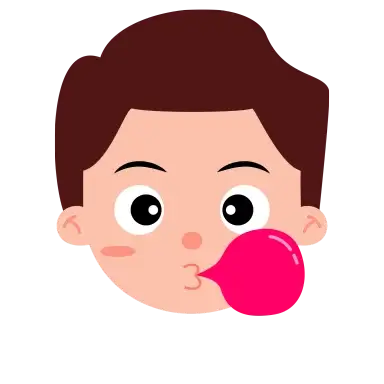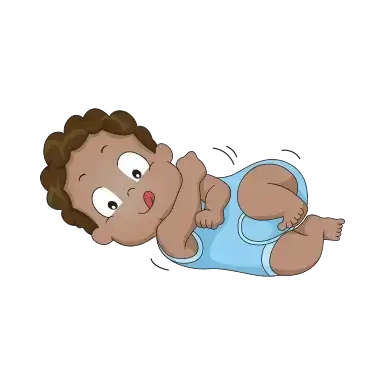Menu

At 3-month-old, your baby is becoming quite the charmer. Flashing those adorable smiles and starting to mimic sounds and actions, it’s a crucial time to engage in conversation with your little one.
As your baby hits 3-months, you’ll notice exciting milestones. By now, you might be feeling more confident in your parenting skills, but it’s normal to have questions.
How often do you feed your 3-month-old? Curious about the best ways to play with them? And, of course, the perennial question: When will they sleep through the night? Fear not; here’s everything you need to know about your budding little person.
At 3-month-old, your baby is becoming more active and social. They’re gaining better control of their body, and their awareness of those around them is growing.
This increased awareness leads to more interactive and enjoyable playtime experiences.
So, prepare for some delightful moments as your little one becomes more engaged and responsive during playtime!
Parents often wonder about the weight and measurements of their 3-month-old. On average, a 3-month-old girl weighs 12.9 pounds, while boys weigh around 14.1 pounds. The average length is 23.5 inches for girls and 24.2 inches for boys.
Whether your baby is close to these averages or not, the key is healthy growth. During this month, your baby may have gained 1.5 to 2 pounds, grown 1 to 1.5 inches, and increased its head size by half an inch.
Teething: Teething typically starts between four to six months, but some 3-month-olds may show signs like increased drooling, mild fever, irritability, chewing on objects, and fussiness. Use safe teething toys, maintain good oral hygiene, and explore age-appropriate remedies
Spitting Up: Spitting up in a 3-month-old baby is common and often considered normal. It happens when a small amount of stomach contents, including milk, is brought up and expelled through the mouth. This can be due to the immaturity of your baby’s digestive system, which is still developing.
Factors like overfeeding, swallowing air during feeds, or a too-fast milk flow can contribute to spitting up. As long as the baby is gaining weight, content, and not showing signs of distress, occasional spitting up is usually not a cause for concern.
As your baby grows in the last couple of months, you’ve likely noticed a significant increase in their appetite. The fascinating part is that they’ve developed a way to communicate their hunger needs.
You’ve probably established a feeding routine, and now, you can easily recognize the subtle cues or the distinct hungry cry that signals it’s time to feed your little one.
Your baby’s diet should primarily consist of breast milk or formula at three months old. Water is generally not recommended at this stage. Most doctors advise waiting until your baby is six months before introducing solid foods.
The main reason behind this recommendation is that breast milk or formula provides sufficient hydration and essential nutrients for your baby’s growth and development.
Introducing water too early could potentially fill your baby’s small stomach without providing the necessary nourishment they receive from milk.
It’s important to follow your paediatrician’s guidance, ensuring your baby receives the appropriate nutrition for their age and developmental stage.
Your baby’s feeding routine centers around breast milk or formula at 3-month-old. Typically, they may be fed every 3 to 4 hours, totaling about 5 to 6 feedings in 24 hours. Breastfeeding sessions may last around 15 to 20 minutes per breast, and bottle-fed babies might consume about 4 to 6 ounces per feeding.
Pay attention to your baby’s cues and ensure they receive the nutrients necessary for continued growth and development. Feeding on demand and maintaining a responsive approach to their hunger signals is key during this stage.
At 3-month-old, your baby sleeps 12 to 16 hours daily, including nighttime and naps. Nights may stretch to 5 to 7 hours, but waking for feeds is common.
Their sleep routine is still evolving, with 3 to 5 naps daily. Be flexible and responsive to their needs as their sleep patterns continue to develop.

At this stage, your baby’s vision is improving rapidly. They can focus on objects and people up close. High-contrast patterns and bold colours are like a mesmerizing show for them. Consider introducing toys or decorations with these features during playtime.

Your baby’s sense of hearing is becoming more refined. They can now recognize familiar voices, so engaging in soothing conversations, singing lullabies, or playing gentle music can be comforting and stimulating for their auditory senses.

During playtime, exploring various textures becomes more important. Your baby is becoming more aware of tactile sensations, so offering different textures through soft fabrics or textured toys can provide a rich sensory experience.

At 3 months old, your baby’s emerging taste preferences and growing sense of smell add new dimensions to their feeding experiences. You may notice them reacting to various tastes, which plays a crucial role in shaping their future relationship with food.
Additionally, their developing sense of smell allows them to explore different scents in their surroundings, enriching their sensory experiences and fostering curiosity about the world around them.

Supervised tummy time is crucial for developing your baby’s motor skills. It contributes to their physical development and enhances spatial awareness, laying the foundation for future mobility.
Your baby is increasingly responsive to social cues. Smiling, talking, and making eye contact during interactions are vital in fostering social and emotional development. These simple yet meaningful gestures create a strong bond between you and your little one.

At this stage, your baby’s vision is improving rapidly. They can focus on objects and people up close. High-contrast patterns and bold colours are like a mesmerizing show for them. Consider introducing toys or decorations with these features during playtime.

Your baby’s sense of hearing is becoming more refined. They can now recognize familiar voices, so engaging in soothing conversations, singing lullabies, or playing gentle music can be comforting and stimulating for their auditory senses.

During playtime, exploring various textures becomes more important. Your baby is becoming more aware of tactile sensations, so offering different textures through soft fabrics or textured toys can provide a rich sensory experience.

At 3 months old, your baby’s emerging taste preferences and growing sense of smell add new dimensions to their feeding experiences. You may notice them reacting to various tastes, which plays a crucial role in shaping their future relationship with food. Additionally, their developing sense of smell allows them to explore different scents in their surroundings, enriching their sensory experiences and fostering curiosity about the world around them.

Supervised tummy time is crucial for developing your baby’s motor skills. It contributes to their physical development and enhances spatial awareness, laying the foundation for future mobility.

Your baby is increasingly responsive to social cues. Smiling, talking, and making eye contact during interactions are vital in fostering social and emotional development. These simple yet meaningful gestures create a strong bond between you and your little one.
Developmental milestones are general guides, and each child progresses at their own pace. Some reach milestones sooner, while others take more time. Your understanding of your child is invaluable, and if ever in doubt about their development, consult a doctor or specialist.

At three months, your baby’s brain is developing rapidly, allowing them to recognize familiar faces, especially those of their caregivers. This recognition signals a growing attachment and sense of security, as they become more familiar with the people who provide love and care.

Improved head control is a significant milestone at three months. Your baby can now hold their head steady, which is crucial for activities like tummy time and interacting with their environment. This newfound stability enables them to explore their surroundings with greater confidence.

Your baby’s visual tracking skills become more refined as they intentionally follow moving objects. This development improves eye coordination and focus, laying the foundation for activities visual attention and exploration.

Vocal development progresses as your baby starts to make intentional gurgling and cooing sounds. These vocalizations are how they communicate and express themselves, showcasing their growing ability to interact with the world around them.

Blowing bubbles may seem simple, but it’s an important milestone in oral motor development. This playful exploration of mouth movements helps strengthen oral muscles and paves the way for more complex speech sounds in the future.

By three months, your baby can recognize and respond to the familiar sound of their mother’s voice. This recognition reinforces the bond between parent and child, providing comfort and reassurance to your little one.

During tummy time sessions, your baby may attempt mini push-ups as they strengthen their neck and upper body muscles. This action is essential for developing the strength and coordination needed for future motor skills like crawling and eventually walking.

Rolling over from tummy to back is a significant motor milestone at three months. It demonstrates increasing strength and coordination in your baby’s muscles and marks an important step towards greater mobility.

Your baby’s auditory awareness expands as they demonstrate the ability to turn towards loud sounds. This responsiveness indicates a growing sensitivity to their auditory environment and helps them orient themselves towards sources of sound.

Hand-eye coordination improves as your baby learns to bring their hands together and bat at toys within their reach. This enhances their ability to manipulate objects and explore their surroundings, fostering cognitive and motor development.

At three months, your baby’s brain is developing rapidly, allowing them to recognize familiar faces, especially those of their caregivers.
This recognition signals a growing attachment and sense of security, as they become more familiar with the people who provide love and care.

Improved head control is a significant milestone at three months. Your baby can now hold their head steady, which is crucial for activities like tummy time and interacting with their environment.
This newfound stability enables them to explore their surroundings with greater confidence.

Your baby’s visual tracking skills become more refined as they intentionally follow moving objects.
This development improves eye coordination and focus, laying the foundation for activities visual attention and exploration.

Vocal development progresses as your baby starts to make intentional gurgling and cooing sounds.
These vocalizations are how they communicate and express themselves, showcasing their growing ability to interact with the world around them.

Blowing bubbles may seem simple, but it’s an important milestone in oral motor development.
This playful exploration of mouth movements helps strengthen oral muscles and paves the way for more complex speech sounds in the future.

By three months, your baby can recognize and respond to the familiar sound of their mother’s voice.
This recognition reinforces the bond between parent and child, providing comfort and reassurance to your little one.

During tummy time sessions, your baby may attempt mini push-ups as they strengthen their neck and upper body muscles.
This action is essential for developing the strength and coordination needed for future motor skills like crawling and eventually walking.

Rolling over from tummy to back is a significant motor milestone at three months.
It demonstrates increasing strength and coordination in your baby’s muscles and marks an important step towards greater mobility.

Your baby’s auditory awareness expands as they demonstrate the ability to turn towards loud sounds.
This responsiveness indicates a growing sensitivity to their auditory environment and helps them orient themselves towards sources of sound.

Hand-eye coordination improves as your baby learns to bring their hands together and bat at toys within their reach. This enhances their ability to manipulate objects and explore their surroundings, fostering cognitive and motor development.
At three months old, your little one is becoming more alert and active, showing a keen interest in the world around them. They’re starting to explore their environment with purposeful movements and are eager to engage with new experiences.
As a parent, providing stimulating activities towards your baby’s development is essential. These activities include;
The American Academy of Pediatrics (AAP) says babies typically don’t establish regular sleep cycles until 6-month-old. Although a three-month-old baby may sleep 12 to 16 hours a day, including naps, it’s important to understand that this sleep is not consolidated into one continuous stretch.
At this stage, it’s normal for babies to wake during the night, often for feeding or other needs. As your baby develops, sleep patterns gradually become more organized, leading to more extended periods of sleep at night.
At 3-month-old, feeding frequency can vary, but on average, babies are typically fed around 5 to 6 times a day. These feedings might be more frequent for breastfed babies, often every 2 to 3 hours.
It’s essential to pay attention to your baby’s hunger cues, such as increased alertness, mouthing, or rooting, as these signals indicate when your baby is ready to feed. Breastfeeding sessions may last around 10 to 20 minutes per breast, while formula-fed babies consume about 4 to 6 ounces per feeding every 3 to 4 hours.
For your 3-month-old, finding the perfect bedtime is key to ensuring a peaceful sleep routine. While experts often recommend around 7:30 pm, it’s essential to consider your family’s unique schedule and rhythms. As babies start sleeping for more extended periods at night, gradually shifting bedtime earlier is recommended.
Surprisingly, an earlier bedtime can contribute to even longer stretches of sleep, as it aligns with a baby’s natural sleep-wake cycle and supports a more restful night. Consistency in bedtime routines helps signal the baby that it’s time to sleep, promoting healthy sleep patterns and overall well-being.
For a 3-month-old baby, toys that stimulate their senses and encourage interaction are ideal. Look for books with high-contrast patterns and textures to engage their developing vision. Rattles with different shapes and textures provide auditory and tactile stimulation, promoting sensory exploration.
Brightly colored mobiles above their crib or play area capture their attention, encourage visual tracking, and enhance their hand-eye coordination. These toys entertain and support crucial aspects of your baby’s cognitive and motor development during this stage.
On average, a 3-month-old girl weighs 12.9 pounds, while boys weigh around 14.1 pounds. The average length is 23.5 inches for girls and 24.2 inches for boys.
Whether your baby is close to these averages or not, the key is healthy growth. During this month, your baby may have gained 1.5 to 2 pounds, grown 1 to 1.5 inches, and increased its head size by half an inch.
The American Academy of Pediatrics (AAP) says babies typically don’t establish regular sleep cycles until 6-month-old. Although a three-month-old baby may sleep 12 to 16 hours a day, including naps, it’s important to understand that this sleep is not consolidated into one continuous stretch.
At this stage, it’s normal for babies to wake during the night, often for feeding or other needs. As your baby develops, sleep patterns gradually become more organized, leading to more extended periods of sleep at night.
At 3-month-old, feeding frequency can vary, but on average, babies are typically fed around 5 to 6 times a day. These feedings might be more frequent for breastfed babies, often every 2 to 3 hours.
It’s essential to pay attention to your baby’s hunger cues, such as increased alertness, mouthing, or rooting, as these signals indicate when your baby is ready to feed.
Breastfeeding sessions may last around 10 to 20 minutes per breast, while formula-fed babies consume about 4 to 6 ounces per feeding every 3 to 4 hours.
For your 3-month-old, finding the perfect bedtime is key to ensuring a peaceful sleep routine. While experts often recommend around 7:30 pm, it’s essential to consider your family’s unique schedule and rhythms.
As babies start sleeping for more extended periods at night, gradually shifting bedtime earlier is recommended. Surprisingly, an earlier bedtime can contribute to even longer stretches of sleep, as it aligns with a baby’s natural sleep-wake cycle and supports a more restful night.
Consistency in bedtime routines helps signal the baby that it’s time to sleep, promoting healthy sleep patterns and overall well-being.
For a 3-month-old baby, toys that stimulate their senses and encourage interaction are ideal. Look for books with high-contrast patterns and textures to engage their developing vision.
Rattles with different shapes and textures provide auditory and tactile stimulation, promoting sensory exploration. Brightly colored mobiles above their crib or play area capture their attention, encourage visual tracking, and enhance their hand-eye coordination.
These toys entertain and support crucial aspects of your baby’s cognitive and motor development during this stage.
On average, a 3-month-old girl weighs 12.9 pounds, while boys weigh around 14.1 pounds. The average length is 23.5 inches for girls and 24.2 inches for boys.
Whether your baby is close to these averages or not, the key is healthy growth.
During this month, your baby may have gained 1.5 to 2 pounds, grown 1 to 1.5 inches, and increased its head size by half an inch.
1. Center for Disease Control and Prevention: Data Table of Infant Weight-for-age Charts
2. Center for Disease Control and Prevention: Data Table of Infant Length-for-age Charts
3. Flo. Health: Can Babies Start Teething at 3 Months? Signs and Useful Tips
4. Nemours Kids Health: Feeding your 1-to-3-month-old
5. Nemours Kids Health: Your Baby’s Growth 3 Months
6. American Academy of Pediatrics
7. New Parent Company: Baby Milestones
8. Sleep Foundation: How Much Sleep Do Babies and Kids Need?
© Mindsmaking 2024